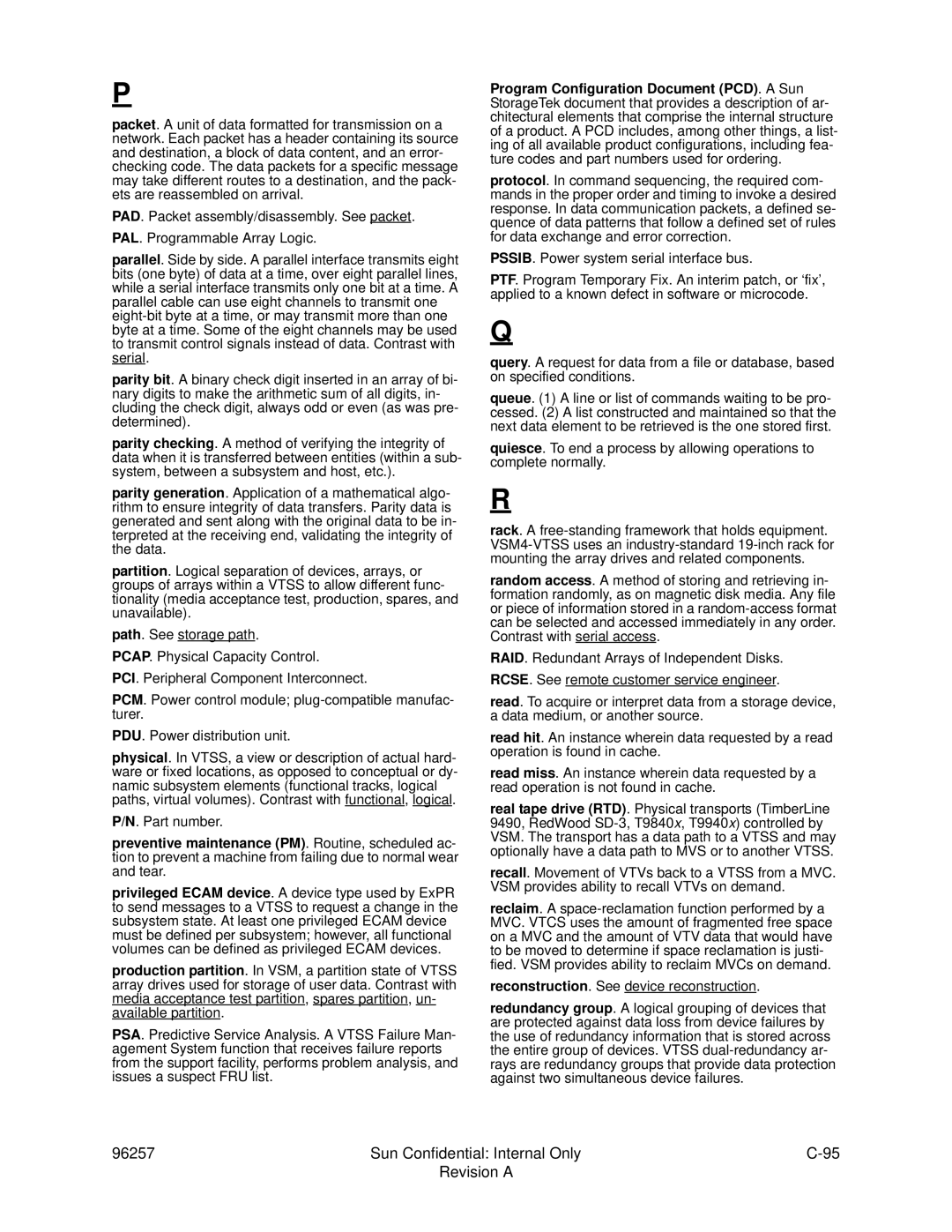P
packet. A unit of data formatted for transmission on a network. Each packet has a header containing its source and destination, a block of data content, and an error- checking code. The data packets for a specific message may take different routes to a destination, and the pack- ets are reassembled on arrival.
PAD. Packet assembly/disassembly. See packet. PAL. Programmable Array Logic.
parallel. Side by side. A parallel interface transmits eight bits (one byte) of data at a time, over eight parallel lines, while a serial interface transmits only one bit at a time. A parallel cable can use eight channels to transmit one
parity bit. A binary check digit inserted in an array of bi- nary digits to make the arithmetic sum of all digits, in- cluding the check digit, always odd or even (as was pre- determined).
parity checking. A method of verifying the integrity of data when it is transferred between entities (within a sub- system, between a subsystem and host, etc.).
parity generation. Application of a mathematical algo- rithm to ensure integrity of data transfers. Parity data is generated and sent along with the original data to be in- terpreted at the receiving end, validating the integrity of the data.
partition. Logical separation of devices, arrays, or groups of arrays within a VTSS to allow different func- tionality (media acceptance test, production, spares, and unavailable).
path. See storage path.
PCAP. Physical Capacity Control.
PCI. Peripheral Component Interconnect.
PCM. Power control module;
PDU. Power distribution unit.
physical. In VTSS, a view or description of actual hard- ware or fixed locations, as opposed to conceptual or dy- namic subsystem elements (functional tracks, logical paths, virtual volumes). Contrast with functional, logical.
P/N. Part number.
preventive maintenance (PM). Routine, scheduled ac- tion to prevent a machine from failing due to normal wear and tear.
privileged ECAM device. A device type used by ExPR to send messages to a VTSS to request a change in the subsystem state. At least one privileged ECAM device must be defined per subsystem; however, all functional volumes can be defined as privileged ECAM devices.
production partition. In VSM, a partition state of VTSS array drives used for storage of user data. Contrast with media acceptance test partition, spares partition, un- available partition.
PSA. Predictive Service Analysis. A VTSS Failure Man- agement System function that receives failure reports from the support facility, performs problem analysis, and issues a suspect FRU list.
Program Configuration Document (PCD). A Sun StorageTek document that provides a description of ar- chitectural elements that comprise the internal structure of a product. A PCD includes, among other things, a list- ing of all available product configurations, including fea- ture codes and part numbers used for ordering.
protocol. In command sequencing, the required com- mands in the proper order and timing to invoke a desired response. In data communication packets, a defined se- quence of data patterns that follow a defined set of rules for data exchange and error correction.
PSSIB. Power system serial interface bus.
PTF. Program Temporary Fix. An interim patch, or ‘fix’, applied to a known defect in software or microcode.
Q
query. A request for data from a file or database, based on specified conditions.
queue. (1) A line or list of commands waiting to be pro- cessed. (2) A list constructed and maintained so that the next data element to be retrieved is the one stored first.
quiesce. To end a process by allowing operations to complete normally.
R
rack. A
random access. A method of storing and retrieving in- formation randomly, as on magnetic disk media. Any file or piece of information stored in a
RAID. Redundant Arrays of Independent Disks.
RCSE. See remote customer service engineer.
read. To acquire or interpret data from a storage device, a data medium, or another source.
read hit. An instance wherein data requested by a read operation is found in cache.
read miss. An instance wherein data requested by a read operation is not found in cache.
real tape drive (RTD). Physical transports (TimberLine 9490, RedWood
recall. Movement of VTVs back to a VTSS from a MVC. VSM provides ability to recall VTVs on demand.
reclaim. A
reconstruction. See device reconstruction.
redundancy group. A logical grouping of devices that are protected against data loss from device failures by the use of redundancy information that is stored across the entire group of devices. VTSS
96257 | Sun Confidential: Internal Only | |
| Revision A |
|
